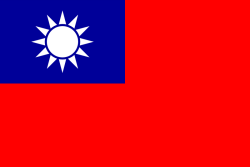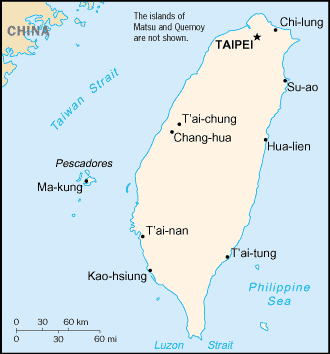Taiwan
Related Categories:

|


|
The "white sun in a blue sky" portion of the Republic of China's national flag was originally designed by Lu Hao-tung, a martyr of the Chinese revolution.
www.gio.gov.tw/
Explanation of the flag, Civil ensign, Presidential standard, Vice President's standard, Military flags, Postal Flags, Miscellaneous Flags at Sea, Sporting flags, Democratic Republic of Taiwan, Customs flag.
www.fotw.us/
The main island of Taiwan, also known as Formosa, meaning "beautiful (island)", is located in East Asia off the coast of mainland China, southwest of the main islands of Japan but directly west of the end of Japan's Ryukyu Islands, and north-northwest of the Philippines.
en.wikipedia.org/
Taiwan's aboriginal peoples, who originated in Austronesia and southern Asia, have lived on Taiwan for 12,000 to 15,000 years. Significant migration to Taiwan from the Chinese mainland began as early as A.D. 500. Dutch traders first claimed the island in 1624 as a base for Dutch commerce with Japan and the China coast. Two years later, the Spanish established a settlement on the northwest coast of Taiwan, which they occupied until 1642 when they were driven out by the Dutch. Dutch colonists administered the island and its predominantly aboriginal population until 1661. The first major influx of migrants from the Chinese mainland came during the Dutch period, sparked by the political and economic chaos on the China coast during the Manchu invasion and the end of the Ming Dynasty.
In 1664, a fleet led by the Ming loyalist Cheng Ch'eng-kung (Zheng Chenggong, known in the West as Koxinga) retreated from the mainland and occupied Taiwan. Cheng expelled the Dutch and established Taiwan as a base in his attempt to restore the Ming Dynasty. He died shortly thereafter, and in 1683, his successors submitted to Manchu (Qing Dynasty) control. From 1680, the Qing Dynasty ruled Taiwan as a prefecture and, in 1875, divided the island into two prefectures, north and south. In 1887 the island was made into a separate Chinese province.
During the 18th and 19th centuries, migration from Fujian and Guangdong provinces steadily increased, and Chinese supplanted aborigines as the dominant population group. In 1895, a weakened Imperial China ceded Taiwan to Japan in the Treaty of Shimonoseki following the first Sino-Japanese war.
During its 50 years (1895-1945) of rule, Japan expended considerable effort in developing Taiwan's economy. At the same time, Japanese rule led to the "Japanization" of the island, including compulsory Japanese education and forcing residents of Taiwan to adopt Japanese names.
At the end of World War II in 1945, Taiwan reverted to Chinese rule. During the immediate postwar period, the Nationalist Chinese (KMT) administration on Taiwan was repressive and corrupt, leading to local discontent. Anti-mainlander violence flared on February 28, 1947, prompted by an incident in which a cigarette seller was injured and a passerby was shot to death by Nationalist authorities. The island-wide rioting was brutally put down by Nationalist Chinese troops, who killed thousands of people. As a result of the February 28 Incident, the native Taiwanese felt a deep-seated bitterness toward the mainlanders. For 50 years the KMT authorities suppressed accounts of this episode in Taiwan history. In 1995 a monument was dedicated to the victims of the "2-28 Incident," and for the first time, Taiwan's leader, President Lee Teng-hui, publicly apologized for the Nationalists' brutality.
Starting before World War II and continuing afterwards, a civil war was fought on the mainland between Chiang Kai-shek's KMT government and the Chinese Communist Party led by Mao Zedong. When the civil war ended in 1949, 2 million refugees, predominately from the Nationalist government, military, and business community, fled to Taiwan. In October 1949 the People's Republic of China (P.R.C.) was founded on the mainland by the victorious communists. Chiang Kai-shek established a "provisional" KMT capital in Taipei in December 1949. During the 1950s, the KMT authorities implemented a far-reaching and highly successful land reform program on Taiwan. They redistributed land among small farmers and compensated large landowners with commodities certificates and stock in state-owned industries. Although this left some large landowners impoverished, others turned their compensation into capital and started commercial and industrial enterprises. These entrepreneurs were to become Taiwan's first industrial capitalists. Together with refugee businessmen from the mainland, they managed Taiwan's transition from an agricultural to a commercial, industrial economy.
Taiwan has developed steadily into a major international trading power with $427 billion in two-way trade (2006). Taiwan's accession to the World Trade Organization in 2002 has expanded its trade opportunities and further strengthened its standing in the global economy. Tremendous prosperity on the island has been accompanied by economic and social stability. Chiang Kai-shek's successor, his son Chiang Ching-kuo, began to liberalize Taiwan's political system, a process that continued when President Lee Teng-hui took office in 1988. The direct election of Lee Teng-hui as president in 1996 was followed by opposition Democratic Progressive Party candidate Chen Shui-bian's election victory in March 2000. Chen was re-elected in March 2004 in a tightly contested election.
www.state.gov/r/
Introduction
About
Contact
Symbols in The News
Interpret this Symbol
AAC
African
AI
Alchemy
Alphabets
Ancient
Animal Symbolism
Architecture
Art
Articles
Astrology
Baha'i
Blissymbolics
Blueprint Symbols
Buddhist
Celtic Symbols
Cemetery
Chinese Symbols
Christian
Circle
City
Codes
Color
Conlangs
Crop Circles
Danger
Da Vinci Code
Designing Logos
Dictionaries
Dreams
Education
Egyptian Symbols
Electrical
Emoticons
Find Images
Fonts
Food
Fraternity
Hamsa
Healing
Heraldry
Hermetic
Highway Signs
Hindu
History
Hobo
Holiday
Icons
iConji
Islamic
Jain Symbols
Japanese, Kanji
Jewish
Justice
Law
Literary Symbolism
Mandalas
Map
Masonic
Math, Number
Meaning of Names
Medical
Middle East
Military
Miscellaneous
Money
Music
Mythology
Native American
Playing Cards
Power
Psychology
QiQiiKhu
Reiki
Religious
Runes, Norse
Sacred Geometry
Scientific
Science Fiction
Sorority
Sports
Symbols in the News
Tattoos
ThirteenSymbols
Tree of Life
Ursprache
Videos
Visual Languages
Weather
Web Codes
Wicca
Words
Writing Systems
Braille
Coinherence
Coptic
Cuneiform
Easter Island
Etruscan
Happy Human
Hebrew
Kokopelli
Linear B
Lotus
Love Symbols
Mandorla
Moon Alphabet
Nine Pointed Star
Om
Oz
Phonetic
Scarab Beetle
Silent
Theosophy
Unifon
About
Contact
Symbols in The News
Interpret this Symbol
AAC
African
AI
Alchemy
Alphabets
Ancient
Animal Symbolism
Architecture
Art
Articles
Astrology
Baha'i
Blissymbolics
Blueprint Symbols
Buddhist
Celtic Symbols
Cemetery
Chinese Symbols
Christian
Circle
City
Codes
Color
Conlangs
Crop Circles
Danger
Da Vinci Code
Designing Logos
Dictionaries
Dreams
Education
Egyptian Symbols
Electrical
Emoticons
Find Images
Fonts
Food
Fraternity
Hamsa
Healing
Heraldry
Hermetic
Highway Signs
Hindu
History
Hobo
Holiday
Icons
iConji
Islamic
Jain Symbols
Japanese, Kanji
Jewish
Justice
Law
Literary Symbolism
Mandalas
Map
Masonic
Math, Number
Meaning of Names
Medical
Middle East
Military
Miscellaneous
Money
Music
Mythology
Native American
Playing Cards
Power
Psychology
QiQiiKhu
Reiki
Religious
Runes, Norse
Sacred Geometry
Scientific
Science Fiction
Sorority
Sports
Symbols in the News
Tattoos
ThirteenSymbols
Tree of Life
Ursprache
Videos
Visual Languages
Weather
Web Codes
Wicca
Words
Writing Systems
Braille
Coinherence
Coptic
Cuneiform
Easter Island
Etruscan
Happy Human
Hebrew
Kokopelli
Linear B
Lotus
Love Symbols
Mandorla
Moon Alphabet
Nine Pointed Star
Om
Oz
Phonetic
Scarab Beetle
Silent
Theosophy
Unifon
